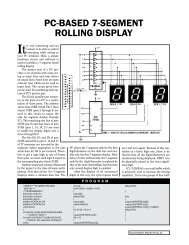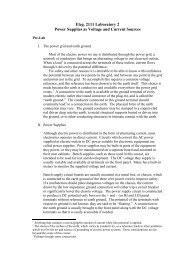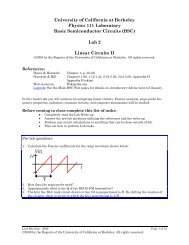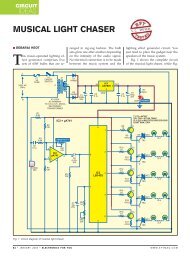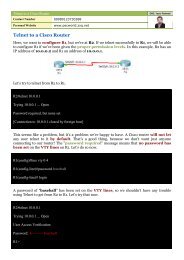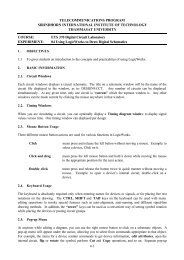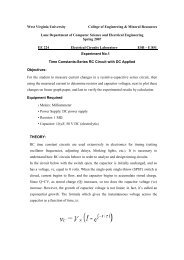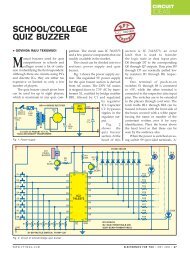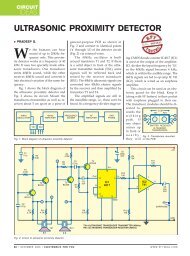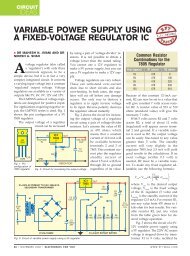WATCHMAN WATCHER
WATCHMAN WATCHER
WATCHMAN WATCHER
Create successful ePaper yourself
Turn your PDF publications into a flip-book with our unique Google optimized e-Paper software.
CIRCUIT IDEAS<strong>WATCHMAN</strong> <strong>WATCHER</strong>S.C. DWIVEDIJAYAN A.R.Here is a circuit that can be used inoffices, stores, warehouses, etc duringnight to check whether thewatchman of your establishment is on duty.For operation, it uses an existing telephone(e.g. in office or store) closest to thewatchman’s post. The watchman is givenan audio alert signal by just ringing theoffice/store telephone once (minimum)from your residence or any other place,an instruction to register his presence bysimply pointing his torch-light beam towardsa wall-mounted LDR sensor unit(without lifting the handset off-cradle ofthe ringing telephone). This is to be donewithin the time period during which thealert lamp glows. If he fails to do it withinthe permissible time, the circuit registershis absence by incrementing a count. If hedoes, the count remains unaltered.Up to nine separate alert rings are consideredhere. The count displayed is thethe circuit are connected across optocouplerMCT2E (IC1) through a resistor-capacitor(R1-C1) combination. The diode in theoptocoupler conducts only duringring pulses. The collector of the optocouplertransistor is normally off and a 5V signal isavailable here. This signal is connectedto the trigger input of IC 555 (IC2) configuredin monostable mode. The time constantof IC2 is set to nearly one minute(1.1RxC). Its output pin 3 is low duringnormal mode of operation and the relay ispreferably using your mobile phone. Thering is detected by the given circuit and thewatchman is also given a visual alert signalby a glowing lamp. The lamp remains ‘on’for a duration of nearly 60 seconds soonafter the ringtone. The watchman is givennumber of times the watchman failed toregister his presence. The mobile phonerecords the called number and call time,and it can be used with the displayed countto get the timing details.The telephone lines (TIP and RING) inde-energised.When the phone rings, the internaltransistor of the optocoupler conducts tocause a high-to-low transition at triggerpin 2 of monostable IC2. Timer IC2 getstriggered on this trailing edge to energiseELECTRONICS FOR YOU MAY 2004
CIRCUIT IDEASMode-Select Table of 74LS192MRpin 14 PL pin 11 UPpin5 DNpin4 ModeH X X X ResetL L X X PresetL H H H No changeL H H Count upL H H Count downNote: X = Don’t carerelay RL1. This relay is used to switch onalert lamp L1. The circuit doesn’t respondto additional trigger inputs for the set durationof the monostable. The caller maycut the phone call after hearing ringbacktone from the called phone.The sensor circuit formed using LDR1activates another monostable 555 (IC6).LDR1 has a resistance of 2.2 kilo-ohms indaylight, which drops below 50 ohms whentorchlight beam falls on it. (An LDR ofnearly 2cm diameter has been used in thiscircuit.) Comparator LM358 (IC5) comparesthe level set at pin 3 (nearly 1V, set using a10k pot) with the level at pin 2.When no light is falling on LDR1, itsvoltage is above 1V and IC5 has a lowoutput at its pin 1. When light is falling onLDR1, its voltage drops below 1V and IC5output at its pin 1 becomes high. This lowto-hightransition is NANDed with the outputof monostable IC2 (via inverters gatesN1 and N2) to form the trigger signal formonostable IC6. So the trigger input isnormally high, which falls when torchlightbeam is focused on LDR1. It returns to highstate when torchlight is switched off. Sothe torch is used as a remotefor triggeringmonostable IC6 and thistriggering is enabled onlywhen alert lamp L1 is‘on.’Monostable IC6 hasa time constant of nearlyone minute (1.1RxC). Itis used to form a downclock signal for 4-bit up-/down-counter74LS192 (IC7). Counter IC7 has two separateclocks for up and down counts (referto the table). For correct counting, it needsone clock line to be high during high-tolowtransition of the other clock line. Otherwise,it counts erratically.To operate counter IC7, the voltagelevels and timings of the two clock inputs(up and down) are to be properly adjusted.Both trigger inputs, i.e. up and downclocks, are asynchronous.The output of monostable IC2 is filteredusing capacitor C4 to remove unwantedtransitions and inverted usingSchmitt trigger inverter 74LS14 (IC3). Thisforms a signal with correct rising andfalling edges. The inverted signal frompin 6 of gate N3 is used as the up clock.Counter 74LS192 (IC7) is reset to zerostate by making its reset pin 14 high throughreset switch S1. The 7-segment, commonanodedisplay DIS1 is driven through IC74LS47 (IC8). When the phone rings, count‘1’ is displayed after nearly one minute.This happens if the watchman fails to focusthe torchlight beam on LDR1.If LDR1 receives light from the torchof the watchman within the allowed timeperiod, the down clock remains high untilthe up clock is high. The counter countsup and then down, so, in effect, the countremains unchanged.All components, except LDR1, are keptin a sealed cabinet with locking arrangement.Only LDR1 is wall-mounted and visibleoutside. This is done to avoid manualresetting of the counter. The circuit is tobe powered by a battery to avoid resettingof the count during power failure.The working procedure can besummarised as follows:1. Initially, when the power supply isswitched on, power-on-reset componentsC8 and R13 reset counter IC7 and the displayshows ‘0.’2. Now dial the telephone number(where parallel system is installed) fromoutside or from your mobile. For the firstring, relay RL1 energises and alert lampL1 glows.3.When alert lamp L1 is off, thecounter is incremented by ‘1.’4. If the watchman focuses the torchlightbeam on LDR1 within the glowingtime of alert lamp L1, the counter firstcounts up and then counts down and finallythe display shows 0. This indicatesthat the watchman is present.5. If the watchman focuses the torchlightbeam on LDR1 after alert lamp L1goes off, up-counting takes place and thedisplay shows ‘1.’ This indicates that thewatchman is absent.MAY 2004ELECTRONICS FOR YOU



